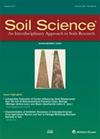农业管理对土壤团聚体和相关有机碳组分的影响:欧洲长期试验的分析
4区 农林科学
Q2 Agricultural and Biological Sciences
引用次数: 0
摘要
摘要在欧洲,逆耕是一种常用的土壤耕作方法,它经常被指责为表层土壤稳定性和有机碳(OC)含量恶化的原因。在本研究中,通过在五个欧洲国家(比利时、捷克共和国、匈牙利、意大利和英国)进行的七项长期实验(从采样时刻起从8年到54年),评估了替代农业管理措施在表土中扭转这些负面影响的潜力。收集并分析了表层土壤样品(0-15 cm),以评估保护性耕作(减少和免耕)和增加不同来源的有机投入(农家肥、堆肥、作物残留物)与翻转耕作结合对表层土壤稳定性、土壤团聚体的影响,以及在这些土壤中使用湿法筛选后的OC分布。采用分散法和粒度分馏法评价了处理对有机物质的两种主要成分,即颗粒物(POM)和伴生矿物(MAOM)的影响。减少和免耕,以及添加粪肥或堆肥,增加了团聚体平均重径(MWD)(在比利时研究地点高达49%)和表土有机碳(在比利时研究地点高达51%),以及与不同团聚体粒径相对应的有机碳。作物秸秆的掺入对MWD有积极影响,但对总OC和与不同团聚体相关的OC的影响不太深远。在所有实验中都发现,微聚集体(53-250µm)的质量与OC含量呈负相关。对大团聚体的质量和被遮挡的微团聚体(mM)没有影响,而相应的有机碳含量则随着耕作次数的减少和有机投入的增加而增加。反耕作导致土壤有机质含量降低,而不同有机投入对土壤有机质含量没有影响。在总POM增加的所有试验中,土壤总有机碳(SOC)也受到正影响。研究结果表明,通过减少耕作强度或添加有机材料,并与非翻转耕作方式相结合,可以缓解翻转耕作对表土的负面影响。本文章由计算机程序翻译,如有差异,请以英文原文为准。
Impact of agricultural management on soil aggregates and associated organic carbon fractions: analysis of long-term experiments in Europe
Abstract. Inversion tillage is a commonly applied soil cultivation practice in Europe, which often has been blamed for deteriorating topsoil stability and organic carbon (OC) content. In this study, the potential to reverse these negative effects in the topsoil by alternative agricultural management practices are evaluated in seven long-term experiments (running from 8 to 54 years the moment of sampling) in five European countries (Belgium, Czech Republic, Hungary, Italy and UK). Topsoil samples (0–15 cm) were collected and analysed to evaluate the effects of conservation tillage (reduced and no tillage) and increased organic inputs of different origin (farmyard manure, compost, crop residues) combined with inversion tillage on topsoil stability, soil aggregates and, within these, OC distribution using wet sieving after slaking. Effects from the treatments on the two main components of organic matter, i.e. particulate (POM) and mineral associated (MAOM), were also evaluated using dispersion and size fractionation. Reduced and no-tillage practices, as well as the additions of manure or compost, increased the aggregates mean weight diameter (MWD) (up to 49 % at the Belgian study site) and topsoil OC (up to 51 % at the Belgian study site), as well as the OC corresponding to the different aggregate size fractions. The incorporation of crop residues had a positive impact on the MWD but a less profound effect both on total OC and on OC associated with the different aggregates. A negative relationship between the mass and the OC content of the microaggregates (53–250 µm) was identified in all experiments. There was no effect on the mass of the macroaggregates and the occluded microaggregates (mM) within these macroaggregates, while the corresponding OC contents increased with less tillage and more organic inputs. Inversion tillage led to less POM within the mM, whereas the different organic inputs did not affect it. In all experiments where the total POM increased, the total soil organic carbon (SOC) was also affected positively. We concluded that the negative effects of inversion tillage on topsoil can be mitigated by reducing the tillage intensity or adding organic materials, optimally combined with non-inversion tillage methods.
求助全文
通过发布文献求助,成功后即可免费获取论文全文。
去求助
来源期刊

Soil Science
农林科学-土壤科学
CiteScore
2.70
自引率
0.00%
发文量
0
审稿时长
4.4 months
期刊介绍:
Cessation.Soil Science satisfies the professional needs of all scientists and laboratory personnel involved in soil and plant research by publishing primary research reports and critical reviews of basic and applied soil science, especially as it relates to soil and plant studies and general environmental soil science.
Each month, Soil Science presents authoritative research articles from an impressive array of discipline: soil chemistry and biochemistry, physics, fertility and nutrition, soil genesis and morphology, soil microbiology and mineralogy. Of immediate relevance to soil scientists-both industrial and academic-this unique publication also has long-range value for agronomists and environmental scientists.
 求助内容:
求助内容: 应助结果提醒方式:
应助结果提醒方式:


